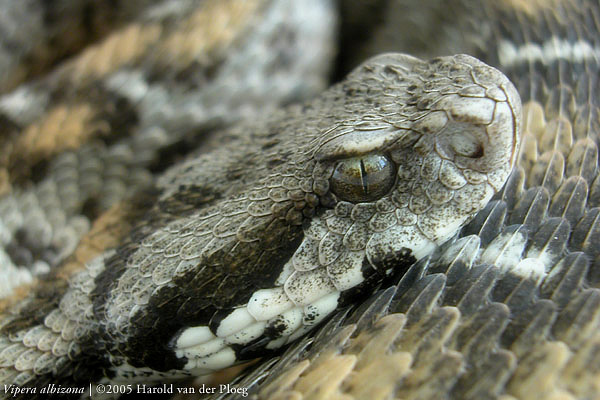- Vipera albizona
Taxobox
name = "Vipera albizona"
status = EN
status_system = iucn2.3

regnum =Animal ia
phylum =Chordata
subphylum = Vertebrata
classis =Reptilia
ordo =Squamata
subordo = Serpentes
familia =Viperidae
subfamilia =Viperinae
genus = "Vipera "
species = "V. albizona"
binomial = "Vipera albizona"
binomial_authority = Nilson, Andrén & Flärdh, 1990
synonyms = * "Vipera albizona" - Nilson, Andrén & Flärdh, 1990McDiarmid RW, Campbell JA, Touré T. 1999. Snake Species of the World: A Taxonomic and Geographic Reference, vol. 1. Herpetologists' League. 511 pp. ISBN 1-893777-00-6 (series). ISBN 1-893777-01-4 (volume).] :"Common names: central Turkish mountain viper.Mallow D, Ludwig D, Nilson G. 2003. True Vipers: Natural History and Toxinology of Old World Vipers. Krieger Publishing Company, Malabar, Florida. 359 pp. ISBN 0-89464-877-2.] ""Vipera albizona" is a venomous viperspecies endemic to the mountainous regions of centralTurkey . No subspecies are currently recognized.ITIS|ID=634984|taxon="Vipera albizona"|year=2006|date=13 August]Description
The maximum is a little less than 78 cm (for a male), although most specimens are smaller.The head is relatively large and distinct from the neck. The snout is rounded and covered with small, keeled scales. The nostril is located within a single
nasal scale . There are 2-3 apical scales in contact with the rostral. There is normally 1 canthal scale on either side of the head. The largesupraoculars are in broad contact with the eye. There are 9-13circumorbitals . Two scale rows separate the eye from thesupralabials , of which there are 7-10. There are usually 10-13sublabials . Thetemporal scales are keeled.Midbody there are 23 rows of keeled
dorsal scales . There are 2-3 preventral scales, followed by 149-155ventrals . Theanal scale is single and followed by 23-30 pairedsubcaudals .The color pattern consists of a grayish ground color. Running along the midline from the back of the head to the tail is a series of about 30 transversed and pronounced white- and black-edged narrow bands separated by a brick-red brown zone 3-4 scales long and 9-12 scales wide. Lateral spots may be small and in a double series. There are usually two large black, oblique spots on top of the head, as well as a dark stripe running from the corner of the eye back to the angle of the mouth or beyond. The belly is grayish and finely speckled with darker spots.
Geographic range
Central
Turkey . The type locality given is "from the regions of the Kulmac Daglari mountain range, central Turkey, close to the Anatolian 'Diagonal'".Conservation status
This species is classified as Endangered (EN) according to the
IUCN Red List of Threatened Species with the following criteria: B1+2e, C2a (v2.3, 1994).Redlist species|no=22985|genus=Vipera|species=albizona|date=2 September|year=2007] This indicates that the extent of its occurrence is estimated to be less than 5,000 km² or the area of its occupancy is estimated to be less than 500 km². Estimates also indicate that the populations are severely fragmented or known to exist at no more than five locations, and that a continuing decline is inferred, observed or projected, in the number of mature individuals. In addition, the total population is estimated to number less than 2,500 mature individuals with no subpopulation containing more than 250 such specimens. Year assessed: 1996.Redlist CC1994|date=2 September|year=2007]It is also listed as a strictly protected species (Appendix II) under the Berne Convention. [http://conventions.coe.int/treaty/FR/Treaties/Html/104-2.htm Convention on the Conservation of European Wildlife and Natural Habitats, Appendix II] at [http://conventions.coe.int/ Council of Europe] . Accessed 9 October 2006.]
Habitat
Very rocky and dry mountain slopes and fields.
Taxonomy
After Nilson et al. (1990) first described "V. albizona" as a separate species that is
parapatric with "V. xanthina", a group of opponents lead by Schätti soon argued that "V. albizona", "V. wagneri" and "V. bulgardaghica" were more likelyconspecific , belonging to the polymorphic species, "V. xanthina". According to Bettex (1993), it was also difficult to tell "V. albizona" from "V. wagneri" based on color pattern alone. However, a study published by Mulder (1994) came out in support of Nilson et al. (1990) and asserted that the color pattern of "V. albizona" is actually quite distinct from that of "V. wagneri".Mulder J. 1994. Additional information on "Vipera albizona". Deinsea 1:77-83. ISSN 0923-9308. [http://www.nmr.nl/Dei1Mul.pdf PDF] at [http://www.nmr.nl/ Natuurhistorisch Museum Rotterdam] . Accessed 2 October 2006.]ee also
*
List of viperine species and subspecies
*
*
*Snakebite References
Further reading
* Bettex F. 1993. Beobachtungen an "Vipera bulgardaghica", "Vipera albizona" und "Vipera xanthina" im Freiland und im Terrarium. Herptofauna 15(86):21-26.
* Schätti B, Baran I, Sigg H. 1992. The "'Vipera xanthina" complex' - a reply to Nilson and Andrén. Amphibia-Reptilia 13: 425.External links
*
Wikimedia Foundation. 2010.
